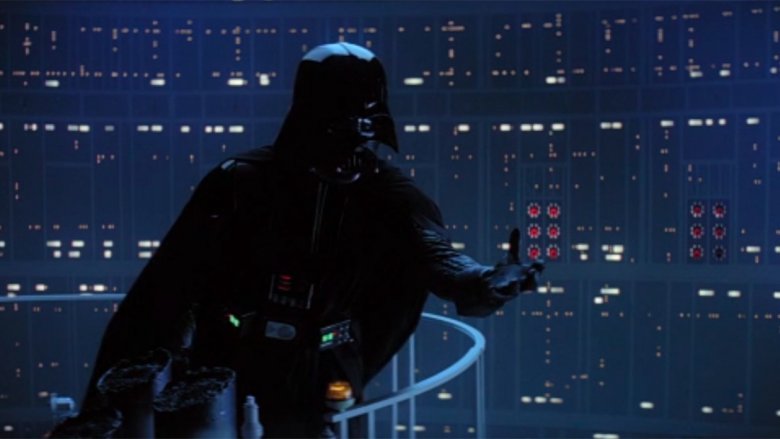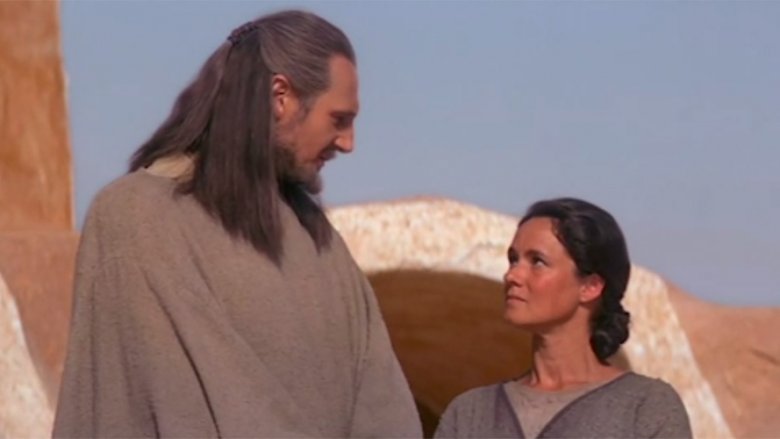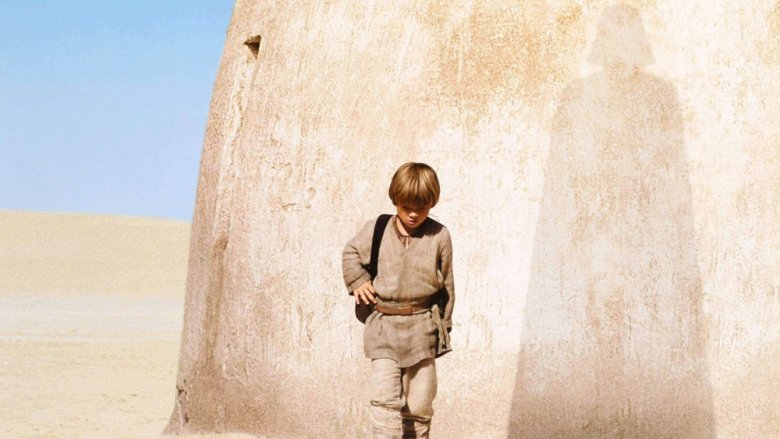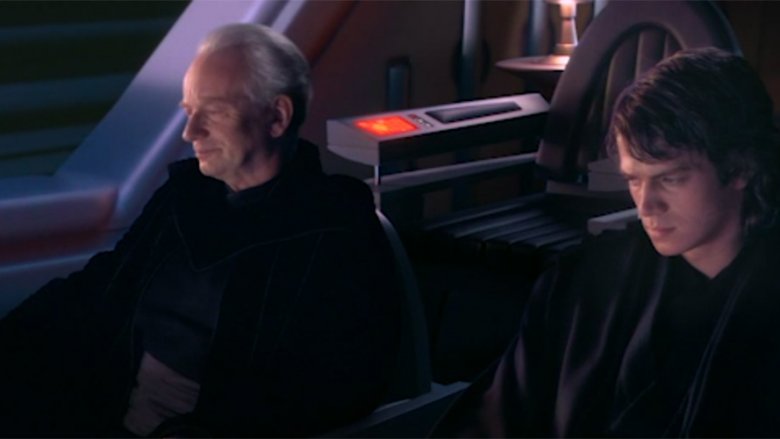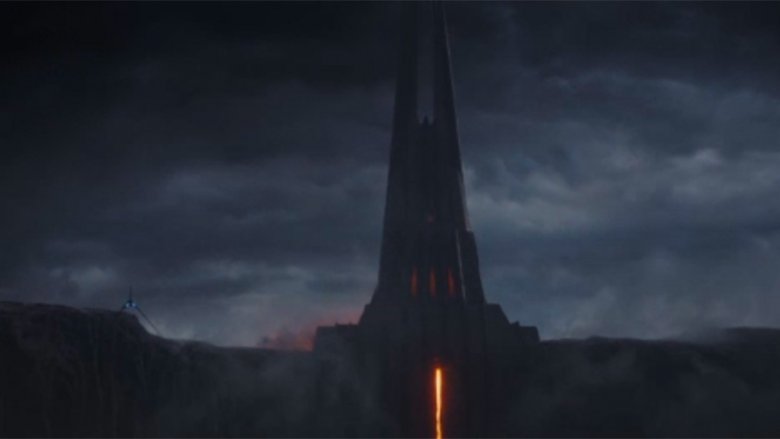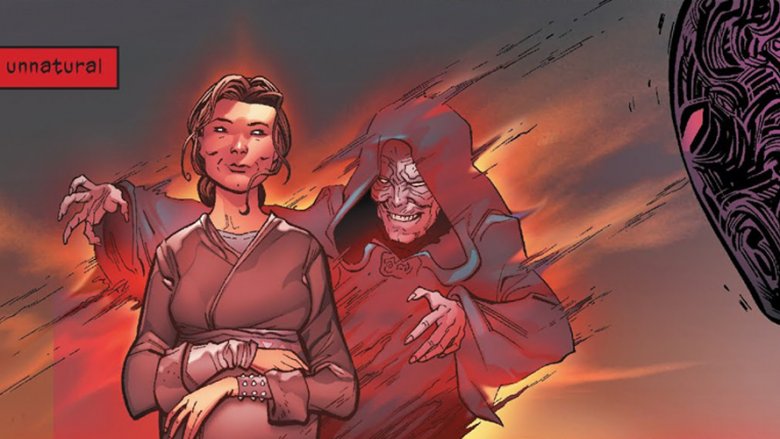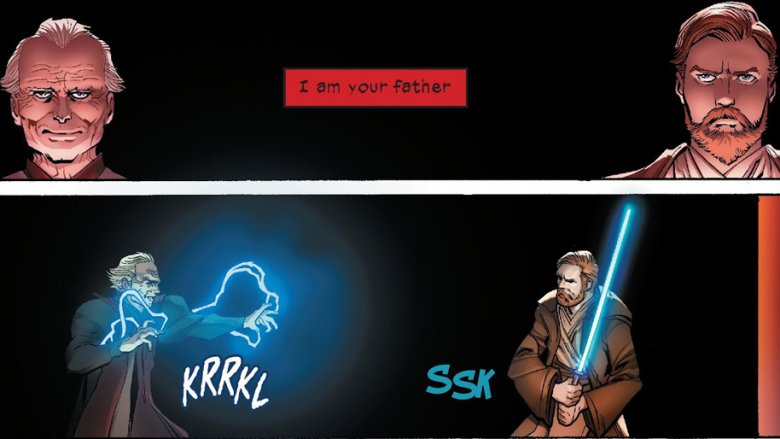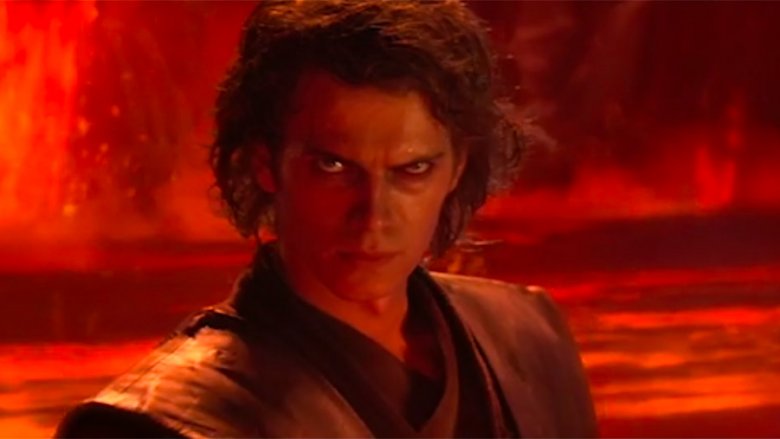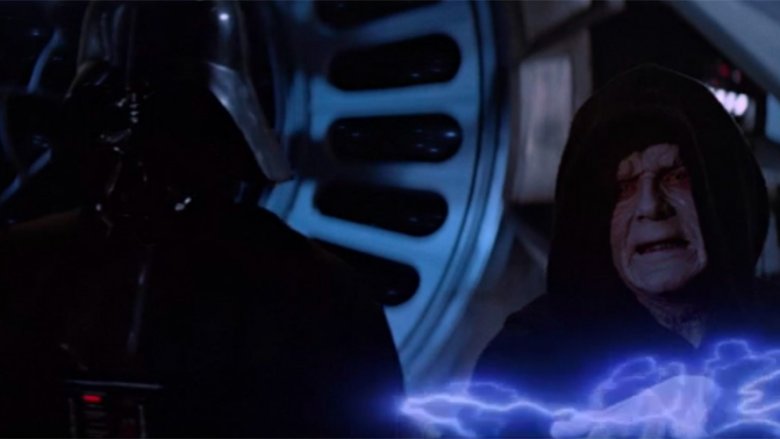The Truth About Who Darth Vader's Father Really Is
For nine movies, a handful of TV shows, and a seemingly endless amount of no-longer-canonical novels and comic books, the Star Wars saga has been focused on the Skywalker family and the legacy that they've left throughout a galaxy far, far away. Through all of that, though, there's one piece of family history that seems a whole lot weirder than the rest: Anakin Skywalker's parentage. It's pretty odd, and considering that the most prominent Skywalker was last seen chilling out with the ghost of a Muppet between swigs of green alien milk, that's saying something.
The identity of Anakin Skywalker's father (or lack thereof) has been a point of contention ever since it was first brought up back in The Phantom Menace. Now, however, we have a piece of information that might shed some new light on the true identity of Darth Vader's deadbeat dad. Here's the truth about who Anakin Skywalker's father really is.
Immaculate conception
The major selling point of the prequel trilogy of The Phantom Menace, Attack of the Clones, and Revenge of the Sith was that we'd be able to see Anakin Skywalker's origins, learning more about who one of cinema's greatest villains was before his fall from grace. In practice, well, we didn't get a whole lot that we didn't already know. He used to be a Jedi, then he went bad, and telling audiences that took six hours and $345 million. There was, however, one Death Star-sized truth bomb hiding in Episode I, and none of us were really prepared for it. When Anakin's mom, Shmi Skywalker, is asked about who his father is, she simply explains that there wasn't one. Instead, she just woke up one morning to find that she was pregnant.
The religious overtones at play here are pretty obvious: a virgin birth foretold in prophecy, heralding the arrival of one who will bring balance to the world. They're also a bit on the nose, even for Star Wars — a series where the guy who's really good at piloting spaceships is named "Skywalker," the guy who doesn't want to join up with the Rebel Alliance is named "Solo," and the first hope for the Light Side of the Force to come along in years is named "Rey." These movies have never exactly been subtle, but giving us a messianic figure via virgin birth is on a whole different level.
Except, of course, that there's a twist to it. Rather than becoming the savior that the Jedi have been waiting for, Anakin grows up to murder a bunch of children with a lightsaber, get rebuilt as a cyborg, and then commit full-on genocide by blowing up entire planets. Not exactly what any parents would hope for their child... unless one of them happened to be a tyrannical overlord devoted to death and corruption, that is.
The midichlorians are over 20,000!
Rather than letting its messianic overtones stand on their own, Episode I did provide a further explanation for Anakin's conception — although it wasn't the kind of thing that fans were happy about. Up until that point, the Force had always been portrayed as being essentially magical, a metaphysical presence that ran through all living things and united the galaxy as one. Then it turned out that it was actually just a bunch of tiny bugs that lived in your blood.
Episode I introduced the concept of midchlorians: microscopic organisms found in the bloodstream forming a symbiotic relationship that allows their hosts to connect with and, well, use the Force. The more midichlorians you have floating around your circulatory system, the more raw power you have when it comes to the Force. It's essentially a plot device, allowing for a quick explanation of why Qui-Gon Jinn and Obi-Wan Kenobi are so convinced that Anakin is a big deal: his "midichlorian count" is over 20,000, which is even more than Yoda's! It's a very big number!
Unfortunately, the implication here is that a bunch of tiny midichlorians got together and decided that they should just go ahead and make a baby inside some woman who had zero knowledge that this was happening, let alone why. That is, at the bare minimum, pretty weird. If nothing else, Luke Skywalker's grandfather being a collection of sentient microbes that construct babies as a hobby is going to make things pretty weird when the whole family gets together on Life Day.
The tragedy of Darth Plagueis the Wise
Did you ever hear the tragedy of Darth Plagueis the Wise? We thought not. It's not a story the Jedi would tell you. It is, however, the subject of one of the best scenes in Star Wars Episode III: Revenge of the Sith.
While watching a space opera, Chancellor Palpatine — soon to claim unlimited power as the Emperor — tells Anakin about a Sith Lord named Darth Plagueis, whose mastery of the Dark Side of the Force was so complete that he could not only stop people from dying, but also create life by manipulating midichlorians. As Palpatine tells both Anakin and the audience, Plagueis passed down this "unnatural" knowledge to his apprentice, who then murdered him in his sleep. This is the tale that leads Anakin, who has just recently been unable to save his mother from death, to study the Dark Side and ultimately become Palpatine's apprentice.
What Palpatine doesn't tell us — although it is heavily implied in the original scene, given the subject matter — is that Plagueis' apprentice was in fact Darth Sidious, perhaps better known as Emperor Palpatine himself. To find that out for sure, you have to dig deep into the rebooted Star Wars canon and keep up with the novels and comics. If you did, then you might already understand that there was a deeper meaning to Sidious telling Anakin about the knowledge of how to manipulate midichlorians to create life.
Road to Mustafar
That all brings us to the recent release of Marvel's Star Wars: Darth Vader #25, by Charles Soule, Giuseppe Camuncoli, Cam Smith, and Daniele Orlandini. It's the final issue of the series — the second and almost certainly not the last Darth Vader comic Marvel has published since Disney acquired the property back in 2012 — and the final chapter of a storyline set on the planet Mustafar.
If the name sounds familiar, that's because this fiery world is where Anakin Skywalker died and Darth Vader was truly born. It was the planet we saw at the end of Revenge of the Sith, where Obi-Wan chopped off Anakin's limbs and left him to die, and where Darth Vader's ominous castle was seen in Rogue One. The comic fills in the gaps between those two events, with Vader's return to Mustafar and the construction of the castle alongside a forgotten Sith Lord called Momin.
In keeping with Vader's obsession with mastering death, Momin himself has managed to persist beyond the grave, existing as a spirit that could possess anyone who donned the helmet that he'd worn in life. By possessing a series of bodies, he helps Vader design and build the castle, which would function as a gigantic key, tapping into Mustafar's connection with the Force to open a portal to the Dark Side itself. Eventually, of course, he betrays Vader and uses the power of the castle to resurrect his body — literally using the Force to recreate life, just as Sidious told Anakin all those years before. Needless to say, since we know that Vader continues to exist in the Star Wars universe and most moviegoers have never heard of Momin, Vader defeats the traitorous spirit, and uses the portal for his own ends.
The truth of the Dark Side
After defeating Momin, Vader taps into the Dark Side in a way that we've never really seen before: his soul leaves his body and merges with the Dark Side itself. It's depicted in a really cool way, with Vader's body shown as a silhouette composed of roiling black and red swirls, with his arms and legs — the cybernetic parts that replaced the limbs he lost to Obi-Wan — as colorless, featureless voids. The visual is both striking and clear: this is Vader as he is within the armor, a creature sustained entirely by the Dark Side, with whatever good remains in him hidden far beneath the tempestuous mass of anger and fear.
As Vader journeys through the strange, hallucinatory terrain beyond the portal, he's shown key moments from his past, complete with disjointed dialogue lifted from the films. And yes: both "Now this is podracing!" and "Are you an angel?" make appearances and have never been more sinister than they are here. Sadly, "Let's try spinning, that's a good trick" doesn't make the cut, but we can't have everything. Point being, we see these moments as they happened in the films, and then we get one that seems new — a memory that Vader himself couldn't possibly have, which must instead be something that he's learning from his communion with the Dark Side.
The image is of Shmi Skywalker, pregnant. At first, she's alone, accompanied by the line she spoke to Qui-Gon back in Episode I: "There was no father." Then, as Vader watches, the spectral image of Darth Sidious appears behind her, accompanied by the word "unnatural" — the exact word that Sidious used to describe Darth Plagueis' life-creating techniques in Episode III. The message here is far more clear than the implication back in that scene at the space opera: Sidious himself had a hand in Anakin's creation, and was manipulating his life to bring down the Republic long before Qui-Gon, Obi-Wan, and Padmé encountered him on Tatooine.
My two dads?
Of course, like a lot of things in Star Wars, not everything Vader sees during his surreal trip through the Dark Side is meant to be taken literally. Like Luke Skywalker's vision in the cave on Dagobah, there's plenty of it that's meant to be shrouded in metaphor. There is, for instance, a scene where Vader's soul has to fight its way past an army of Jedi who were killed during Palpatine's coup, which is less about their ghosts actually showing up for the Jedi equivalent of revenge, and more about Vader metaphorically "killing" the person he was before his fall. The Kylo Ren quote that echoes backward through time to accompany this moment, "Let the past die; kill it if you have to," tells us as much.
There is another scene where this becomes very important, though, and it's accompanied by what is unquestionably Vader's most famous piece of dialogue: "I am your father." That in itself is a prophetic glimpse of the future — this story takes place long before Vader will utter those fateful words to Luke Skywalker in Cloud City — but it's also connected to the past. The phrase is positioned on the page so that it's suspended between images of Palpatine and Obi-Wan, Anakin's two father figures. Each of them guided Anakin as their apprentice, and ultimately, each of them will fail him in their own way. In the vision, Palpatine and Obi-Wan face off in the fight they never had in the movies, with Palpatine winning. Then, Vader strikes the Emperor down himself to continue on his journey.
The idea of these two men as father figures plays into the Star Wars saga's prominent themes, but that scene in particular echoes what we see from Luke's vision on Dagobah. In that flim, Luke strikes down the character that we will eventually learn is his father, only to discover his own face underneath Vader's mask. Here, in the comic, Vader kills Palpatine with a shower of force lightning, which foreshadows their final conflict in Return of the Jedi, and recontextualizes what we see there. Just like in Empire, Vader's true face is revealed, but he bears very little resemblance to Luke. Instead, his face, pale and ruined from years of embracing the Dark Side, looks a lot more like Palpatine's.
Script notes
It's worth noting that this particular idea didn't just spring into existence on the comics page, even if that's where it truly became canon. It doesn't even have its origins in being heavily implied by the Darth Plagueis scene in Revenge of the Sith. Instead, it comes directly from George Lucas, who just straight up told us years ago that Palpatine was Vader's father.
You could be forgiven for missing it, though, since it never made it to the movies, and only showed up in Lucas's original draft for the Episode III script. It did, however, end up printed in the film's companion book, The Making of Revenge of the Sith. As Lucas originally imagined it, the scene was an echo of the famous confession in The Empire Strikes Back, with Palpatine telling Anakin, "I arranged for your conception... you could almost think of me as your father." As for Anakin's response, it would have been one that sounds pretty familiar in the context of the larger saga: "That's impossible!"
Again, this was cut out of the final version of the script, so in that regard, it's about as canonical as Luke's last name being "Starkiller." Still, it lines up pretty neatly with everything we've seen already, and definitely lends credence to the idea that what Vader sees in Darth Vader #25 is actual history and not just a metaphor or hallucination brought on by the Dark Side.
Rise of the dads
In the end, we're left with the question of what all this means for the future of Star Wars. On one level, this is just another entry in the saga's long line of sons dealing with the legacy that was passed down by their fathers, matching right up with Luke and Vader or Kylo Ren and Han Solo. It's a recurring theme, and given that Palpatine plunged to his death back in 1983, it doesn't seem likely that it'll be anything more than just another branch on the complicated tangle that is the Skywalker family tree.
Or, at least, it wouldn't seem likely if we were talking about this a year ago. In the time since, we've seen that the trailer for Episode IX: The Rise of Skywalker closes with the sinister echo of Palpatine's laugh, and we already know that Ian McDiarmid, who played Palpatine in Return of the Jedi and the prequel trilogy, is set to make an appearance in the film. Considering the timing of the issue and the fact that its big reveal came after these elements were already in place, it seems likely that it's going to come up in some form when Episode IX hits theaters.
If nothing else, we're going to be seeing Darth Sidious knowing, for the first time, that he's much more tied into the Skywalker family than we thought. Whether that's in the form of flashbacks, a first Dark Side Force ghost, or even a shocking return from a pretty definitive death, it's bound to have an impact.
